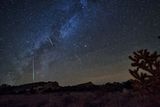October 2025 is a month of meteor showers. In fact, while the Draconids will continue today and tomorrow, the Orionids will shine their strongest in about two weeks or so. Though the first tends to be a little less impressive, the second is often one of the most stunning showers of the year, making it a must-see for many sky- and star-gazers.
Here are some suggestions for observing these sister showers this year — if you haven’t spotted them already.
Read More: Thousands of Meteorites Hit Earth Each Year — Here’s What They Bring
The Draconids Meteor Shower
The Draconid meteor shower is a famously short shower, which stops almost as soon as it starts. This year, the show was forecasted to stretch from October 6, 2025, to October 10, 2025, when it would be seen in the evening instead of the early morning. It’s created from the debris of the comet 21P/Giacobini-Zinner, which orbits the Sun once every six to seven years or so.
The shower’s predicted peak occurred on October 8, 2025, when it would’ve been most visible around sunset, as the sky started to darken. That said, it was probably difficult to spot. That’s because the shower would’ve shared the sky with a bigger, brighter moon. Indeed, the peak of the shower occurred only a couple of days following a supermoon, a full moon that occurs at around the same time that the satellite is at its perigee, or its closest position to our own planet. The moon’s size and brightness in the sky would’ve overshadowed the shower’s shine, making it less likely for observers to see the Draconids sparkle.
Spotting the shower today or tomorrow isn’t especially promising, either, though your best bet will be to look to the constellation Draco in the northern sky. You might not observe anything, but there will always be another chance to see the Draconids — that is, if you’re willing to wait.
The Draconid meteor shower occurs annually, as our planet passes through the same spot of cometary dust in our Solar System. Most of the time, only a few meteors are visible. But stronger showers, or meteor storms, occasionally occur, featuring thousands of sparks shooting through the dark.
Read More: Near-Earth Asteroids Could Supply Future Meteor Showers
The Orionids Meteor Shower
If a year is too long to wait for the next Draconids showing, then there’s another opportunity to observe meteors in October. The Orionids meteor shower, which is predicted to peak around October 21, 2025, could cause an astronomical scene, with meteors appearing at intervals of only a few minutes.
It’s the debris from comet 1P/Halley, more commonly called Halley’s comet, that sparks this spectacle, which also occurs once a year. (The comet, meanwhile, takes 76 years to orbit the sun.) In 2025, the shower will span from September 26, 2025, to November 22, 2025, with the strongest chances of seeing something special occurring between 12 AM and 2 AM on the morning of its maximum activity.
Your odds of spotting the Orionid shower may be better than your odds of seeing the Draconid shower, if you haven’t caught them this year already. Not only are the Orionids longer lasting, they’ll also appear in a moonless sky, since the shower’s climax will coincide with a new moon.
To see the Orionid meteor shower, travel to a dark area (away from urban or suburban lights), and turn towards the southeastern sky. You might see meteors concentrated around the Orion constellation, though some may appear around other stars, too. So, shake yourself awake, and make sure to pay attention — you might just see something spectacular this October.
Article Sources
Our writers at Discovermagazine.com use peer-reviewed studies and high-quality sources for our articles, and our editors review for scientific accuracy and editorial standards. Review the sources used below for this article:
- NASA. What’s Up: October 2025 Skywatching Tips from NASA
- NASA. 21P/Giacobini-Zinner
- NASA. Supermoons
- NASA. Meteors & Meteorites Facts
- NASA. 1P/Halley

